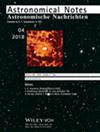摘要
根据射电特性,类星体可分为射电响和射电静两种。长期以来,这种二分法的物理机制一直是一个活跃的研究领域。在这项工作中,我们分析了与 SDSS DR14 和 FIRST 星表匹配的 851 个类星体的多波长数据,要求测量信噪比为 > 3 的发射线,拟合类星体的光学连续谱,并计算射电响度、光度和爱丁顿比。我们用 log L 6 cm = - 2.7 log R + 44.3 $$ \log {L}_{6\mathrm{cm}}=-2.7\log R+44.3 $$ 的分界线把类星体分为射电响度大和射电安静两种。我们发现,在射电噪声大的类星体和射电噪声小的类星体之间,埃丁顿比和射电光度的分布是不同的,埃丁顿比和射电噪声之间的相关性也是不同的。在整个样本和射电噪声大的类星体中,埃丁顿比值与射电响度呈弱正相关,这意味着埃丁顿比值对射电响度有影响,但不是主要因素,射电噪声大的类星体中还有其他因素影响相对论射流的产生。然而,在射电安静的类星体中,埃丁顿比与射电响度是反相关的,这可能与吸积盘的特性有关。Quasars can be categorized into radio-loud and radio-quiet populations based on radio properties. The physical mechanisms underlying this dichotomy have long been an active area of investigation. In this work, we analyze multi-wavelength data from 851 quasars matched between the SDSS DR14 and FIRST catalogs, requiring emission line measurements with signal-to-noise ratios > 3, we fit quasar optical continuum spectra and compute the radio loudness, luminosities, and Eddington ratios. We classify quasars as radio-loud or radio-quiet using a dividing line of . We find that the distribution of the Eddington ratio and radio luminosity is different between the radio-loud and radio-quiet quasars, and the correlation between the Eddington ratio and radio loudness is disparate as well. The Eddington ratio shows a weakly positive correlation with radio loudness in both the whole sample and radio-loud quasars, which imply that the Eddington ratio contributes to the radio loudness but it is not the dominant factor and that additional factors influence relativistic jet production in radio-loud quasars. However, the Eddington ratio is anti-correlated with radio loudness in radio-quiet quasars, potentially related to the properties of the accretion disk.

 求助内容:
求助内容: 应助结果提醒方式:
应助结果提醒方式:


